Radiant heating systems are very common in concrete floors now because they provide a very balanced and comfortable distribution of heat. Those systems are most commonly hydronic, meaning heated liquid is pumped through tubing in the concrete which then radiates that heat into the house.

|
|
Hydronic radiant tubing for a slab-on-grade floor © Ecohome
|
You can see a Video Guide onHow to Install Hydronic Radiant Heated Floor Tubing HERE
Alternatively, you can heat floors with electric wires and this is often the most affordable after-market solution for happier feet. Even in new homes with forced-air heating, electrically-heated mats are sometimes installed below the tiles in bathroom floors for added comfort. What you don’t see a lot of, are floors heated with air.

|
|
Electric wire radiant floor heating © Ecohome
|
How to make air-heated floors work:
Since the first forced-air heating systems were introduced into homes, there have been attempts to distribute that heat through flooring systems, but they often failed miserably. The most problematic of those were attempts to heat concrete floors with standard metal ducts from forced-air furnaces.
 |
|
Collapsed duct © Inspectapedia |
Embedding ducts in concrete that were not intended to bear weight frequently caused them to collapse, rendering the heating system completely ineffective. Ducts that didn’t collapse were at risk of filling with water or at the very least, moisture. This led to corrosion and blockages, so even systems that worked at first were at risk of a short functional lifespan.
 |
|
Corroded duct © Inspectapedia
|
For the systems that did work, and during the time they were working, they would have offered at least some success in warming floors, but doing so brought air quality concerns. These makeshift floor-heating systems functioned similarly to any other forced-air ducted system, where air from the home was circulated through heat vents and cold air returns.
Circulating air from the home though these floor ducts led to the normal dust and debris that can be found in any home being deposited in these floor ducts, and overtime created a buildup of organic matter.
 |
|
Corroded vent image via Inspectapedia
|
In summertime when systems were inactive, dust-filled ducts embedded in cool, humid concrete floors provided the ideal environment for mold to develop. In the fall when systems were activated again, air circulating through dirty and moldy ductwork would distribute particulate and mold spores throughout the home. For Information about the importance ofair quality in the home and how to improve it with ERV & HRV Ventilation systems see HERE.
During inspections with remotely operated cameras, some even less appealing discoveries were made, including snakes, insects, dead rodents and their excrement. If youreallywant to, you canread more about that here.
How these flaws can be remedied:
- Make it a sealed, closed-loop system so that air in the heating system is not exchanged with the air of the house.
- Install non-corrosive duct work.
- 在系统被激活之前,对混凝土进行养护以去除水分。
A company calledLegalettthat originated decades ago in Sweden now manufactures and distributesheated-floor systems across North America (you can get a quote here). They are the only company we know of that provides this system; if anyone knows of others, please let us know in the comments section at the bottom.
Why the Legalett radiant floor system works:
Legalett air-heated radiant floor heating systems are entirely embedded in concrete, including the heater box. It is a closed-loop system where air is moved through either 2 or 4-inch PVC tubes (which are non-corrosive), so that no dust from the air in the home is introduced into the system. There are no open vents, so there is no access point for rodents and insects.
混凝土浇筑后,Legalett要求使用露天建筑加热器(系统配备)养护地板,在安装永久加热设备之前,该加热器的温度保持在28°C 3周。这样可以除去混凝土中的水分,防止加热箱内的金属部件被腐蚀。
Advantages of air-heated radiant floors over hydronic:
- Legalett采暖机组与管道一起嵌入地板,因此它们不需要在机械室中安装一面墙来放置锅炉和歧管。单元通过与混凝土齐平的小舱门进入,可以放置在家庭的任何地方——机械室、电器下或壁橱中。
- A metal box frame is hard-wired and embedded in the concrete to house heater units, the heater units themselves plug directly into the box to allow for easy removal for maintenance.
- Heater units use standard parts, so, long into the future when the warranty has expired, units can be easily removed and repaired by any electronics repair shop using commonly available parts.
- The first 10-12% of each zone output is fully-insulated, the second 10-12% is half-insulated – this forces the hottest air further down the tubes to more evenly distribute heat throughout the floor.
- With the system being entirely embedded in the floor, heat is also entirely contained in the floor, so there is no buildup of heat in the mechanical room as is common with hydronic systems.
- The reduced capacity air has to hold heat compared to water can reduce the risk of overheating.
- 当安装一个液体循环管系统,你需要非常谨慎,因为不小心刺穿一个管会使系统无效。空气加热管系统是不加压的,没有液体泄漏,所以一个意外的螺丝放入空气管是没有后果的。
- 每个系统和区域布局都是定制设计的,以均匀输送热量。提供了详细的切割清单和说明,使安装简单快捷。
- Systems can be used in conjunction with thermal-solar air heaters, which are less risky (and less expensive) than thermal-solar hydronic heaters.

|
|
Insulating air tubes near the heater box output to better distribute heat © Ecohome
|
Can radiant floor heating provide all the necessary heat for a home?
理论上是可以的,但它不符合加拿大建筑规范的要求。根据规定,在地面温度低于17摄氏度的情况下,通风空气不能进入建筑物,在墙壁或天花板高处的通风口不能进入13摄氏度以下的环境。正因为如此,家里的每一个全管道通风系统,任何类型的辐射热都需要补充加热,将通风空气加热回环境温度。
值得注意的是:代码中的要求与供暖系统是否有能力提供整个建筑的热负荷无关,这只是为了舒适,并确保我们不会因为走过一个通风口而遭受任何创伤,这个通风口的温度是刺骨的16摄氏度。
With traditional heating systems like forced-air furnaces, ventilation air is typically mixed with the already-heated indoor air to achieve the temperatures listed above. Because that option isn’t available with radiant heating systems, a touch up heater must be used with ventilation air. MostHVAC systemswill offer it and it is not an expensive upgrade.
Can air-heated radiant floors deliver enough heat?
Yes, they can. While it is true that much more heat can be transported by water than air, that doesn’t mean there isn’t enough. More power can be delivered by a Boeing jet engine than a 4-cylinder Toyota engine, but if you were purchasing a Toyota and you were given a choice between those two engines, which would you choose? Bigger isn’t always better. Any home-heating system needs to be designed and sized to meet the heat load of a specific building.
如果一栋平房安装了ERV或HRV,使用内联新鲜空气加热器(按照规范要求),那么Legalett地板加热系统可以在正常使用下提供建筑所需的所有额外热量。他们为3.5万平方英尺的建筑提供了全部的热负荷(不包括化妆热)。
地暖系统只是该公司提供的一部分,他们提供工程筏板套件,并已在北美安装超过200万平方英尺。

|
|
2-inch air heated tubes © Legalett
|
Heating with electricity but avoiding peak rates:
An additional benefit that can be realized with any heated concrete floor (air, electric or hydronic), is that the floor itself acts as athermal battery. A warmed slab of concrete will take a long time to cool, long enough to last through peak hours.
Floors can be kept on a timer, set perhaps to go on no sooner than 7:00 PM and off again by 7:00 AM, so you can avoid daytime peak rates. A well-insulated warm concrete floor can easily keep a house warm for 12 hours, allowing you to heat your home affordably with electricity in regions with high peak-electricity rates, without using fossil fuels.


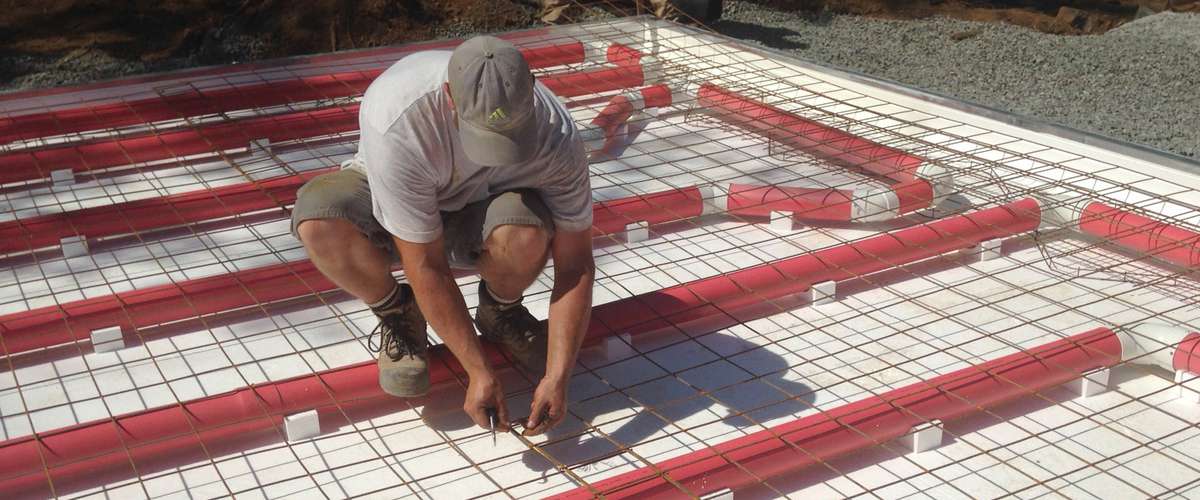











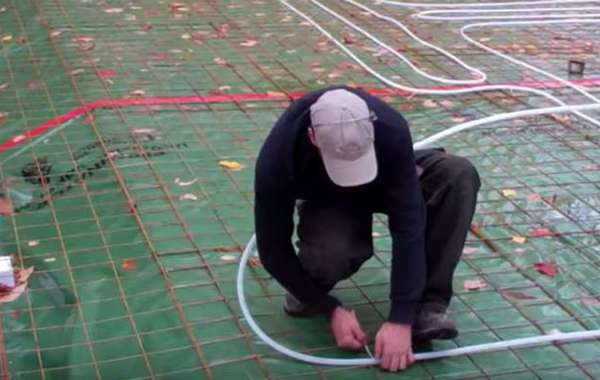
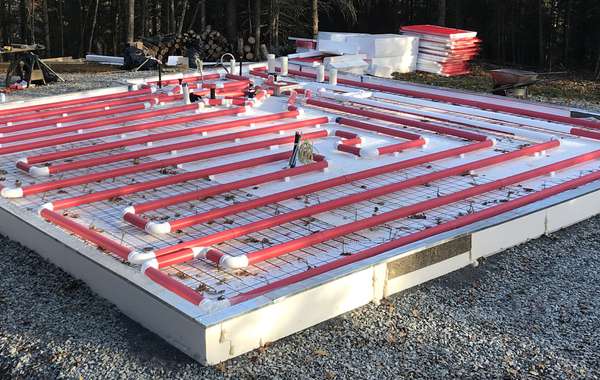
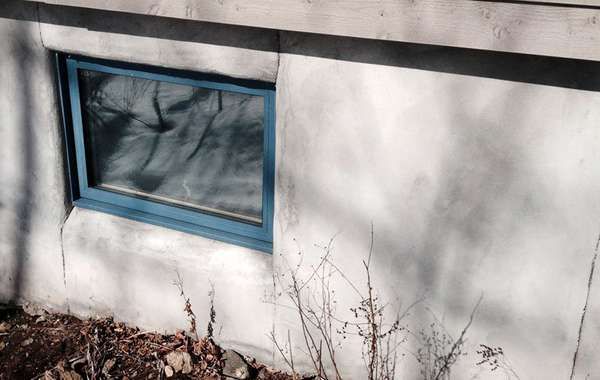
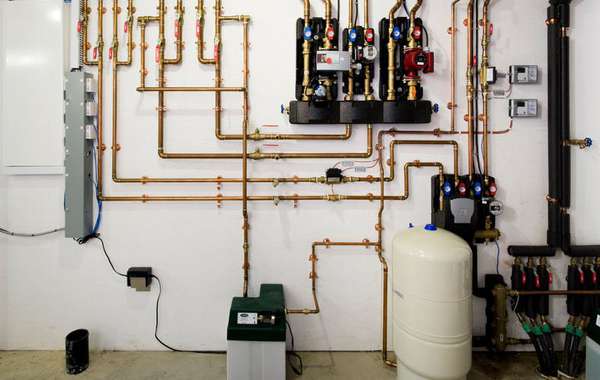
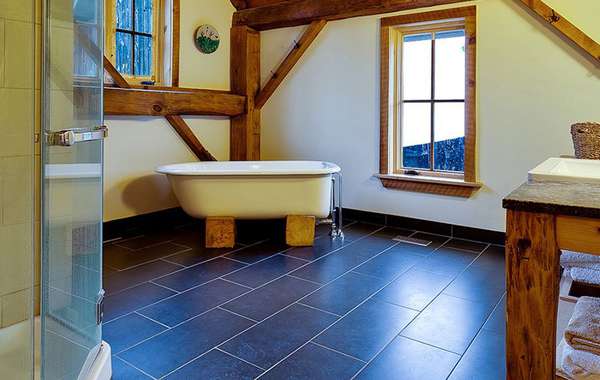
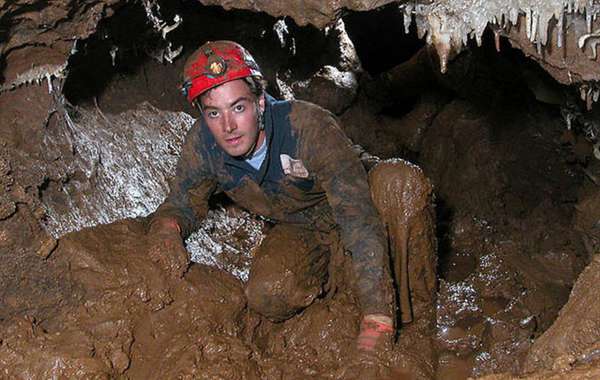
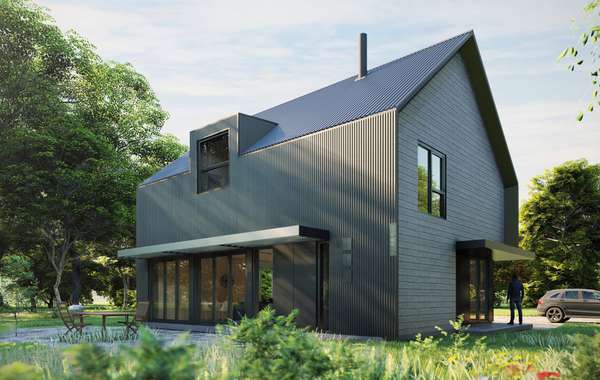
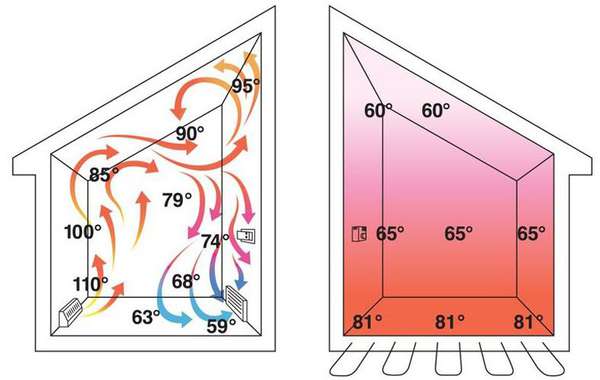
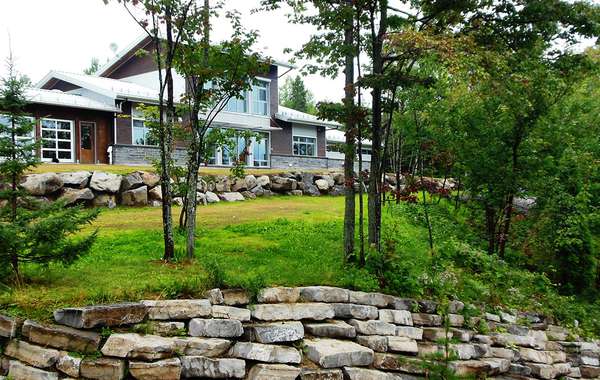
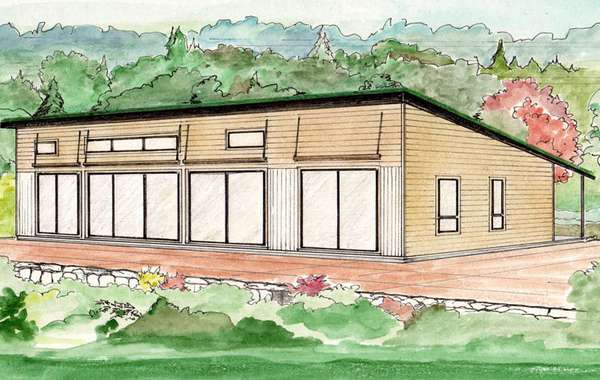
来自新斯科舍省的唐·罗斯科多年来一直在建造被动式太阳能住宅,在混凝土地板上安装暖空气。我“偷”了他的想法,建了3座房子,是他的一部分,结果很好。从来没有霉菌的问题。
His idea: first layer insulation, on top vapor barrier, than gravel with air pipes and on the end register like a normal air furnace, on top the concrete slab floor. The air intake is from the top of the cathedral ceiling and blown constantly with a low speed fan to circulate under the concrete floor. The houses I have built were low cost houses. The only heat source beside having most of the windows on the south side of the house (passive solar) came from a small wood stove.(One house had a propane heat back up). The house performed not only great in the winter time with radiant heat it also helped to stay cooler in the summer time, by transferring some of the heat in the slab
Hello Richard. If it is possible, I would like to have your advice regarding a hot air floor heating sistem. Please contact me, or give me your contact. My email is[email protected]
谢谢!
Hi Richard, I'm looking at doing a new build with a similar setup with bringing warm air from the top of the house to hopfully heat the concrete slab in the basement. If you see this would you be able to contact me as well at[email protected]. I'd be interested to pick your brain a bit on this. Thanks!
听起来唐是个很有创意的建筑师,你很聪明,受到了他的启发。你们俩似乎都避免了任何管道坍塌,这是好消息,但如果是我,我可能会偶尔清理一下管道,以确保安全,尤其是用木火炉,因为空气中通常有更多的颗粒物。Richard,感谢你的分享,我们喜欢通过创新的方式来分配热量,增加舒适度和效率。致以最亲切的问候。
我发明了一种新的方法来创造一个壁腔,通过它空气可以在没有管道、管道或管道的情况下闭环循环。空气从一边加压,从另一边抽真空。腔体的形状和设计确保了结构中最大的热量储存,温度分布均匀,减少湍流,并在空气和结构之间直接传热。空气由装有除湿器的机组循环;臭氧杀菌器;以及加热器或冷却盘管。这样,墙壁上的水分就会被抽走,臭氧会杀死霉菌,墙壁也会被加热或冷却。
空腔15mm,可用于整个建筑表面(墙壁、地板、天花板)室内外的抹灰或找平层。它的响应时间很快。
The invention granted an Austrian patent and filed it in the US. I am looking for a partner.
There is/ no reason that any building should depend upon only one energy source...and none truly do so.
But I've been seeing people say you can't build a 100% solar heated/cooled house since the early 1970's, and seen a great many buildings which had excessive cooling costs because they had too much solar intake.
I can see that this could have some advantages--one disadvantage is that an hydronic system can be built using less concrete. I'm not really sure how much of a problem stray screws or nails are in poured concrete flooring.
Any building hoping to have low energy costs should have an ERV/HRV in the design.
Hi Charles,
It does take a thicker concrete pad to do this, no doubt that is a drawback in cost as well as greenhouse gas emmisions. That said, with smaller houses it doesn't actually require that much more concrete since this design is a raft slab. Rather than having a 2 foot wide and 15-20" deep footing along the perimeter, this is a consistant 8" over the entire surface. So with a small total area, not having a footing offsets that thickness a bit when you calculate the total amount of concrete needed.
We will soon be building an air-heated slab like this for our next demonstration house, and at about 750 square feet, not having a deeper footing means that there is only an additional 2 cubic meters of concrete required than had we gone with a thinner slab that required a thickened-edge footing.
Slabs with larger total footprints would use more concrete of course, as the depth of the footing represents a much smaller percentage of the entire floor surface.
There are other benefits that come with a raft slab like this as well, the deeper concrete means more thermal mass to help balance temperatures.Thermal mass in a home can shave the peaks off of a heat wavein summer and perhaps eliminate the need for artificial cooling. And a raft slab is much more solid so it doesn't crack or shift.
Hi, just discovered you site - very exciting! Have you considered putting the tubes in a shallow sand bed beneath the slab, then you can use a standard 4" slab. I have a design (still to be built) using solar hot air panels for the air ducted under the slab - starting in fall to "charge" the sand bed. A compromise between a PAHS design and conventional radiant system.
Hi Noah ... intrigued by your post - and Mike Reynolds reply. I too - am designing a 'Thermal Battery' type of Air/Heat Storage in Limestone 'Dust' ( sand ) readily available here in Kentucky. I've investigated the "GreenHouse in the Snow" concept utilized by Russ Finch in Alliance, Nebraska. And - further research by "Green Cube Research", Oak Ridge, Tenn ... sounds like the 'Air-to-Sand' concept would work ... with enough MASS and proper air flow ? ... Your thoughts Mr Reynolds ? Thanks - to BOTH of you.
Hi William, I would first say that while I know how they work, I am not an expert in thermal batteries, nor do I know how much heat can be stored in limestone dust. But if you’re running tubes of heated water or air through any kind of mass, then it will store and later release heat. So it sounds to me like it will work, but to what degree I can’t really say. Using local materials is always a good idea when possible so that’s a plus, and if you feel so inclined please take some photos you can share with us and let it know how it works out!
A slab should have gravel and not sand below, especially in wet areas. With sand you could have some extra moisture do to capillarity.
Hi Noah,
Glad you like the site, thanks! About that design you mention - do you mean install insulation, then a layer of sand with ducts, then concrete? I assume you mean for the sand to replace some concrete and allow for the necessary depth to accomodate ducts, but no, given some of the failures in the past we did not consider that. Installing standard air ducts in floors has been done, sometimes successfully, but sometimes with complete failure as well so its not a risk we would take.
I do know of a builder than builds greenhouses that way, he uses the sand instead of concrete and runs pex tubes through it so it acts as thermal mass as well as the final floor. We do like when people share ideas so if I've mistaken something in the design let us know, and thanks for sharing!
You do want gravel under the concrete slab to prevent to much moisture do to capillarity.
What options do you have for flooring over a radiant slab like this? Concrete tends to be hard on the joints but you also don't want to use flooring that will keep the heat trapped in the slab. Any recommendations?
There are lots of flooring options you can put on top of a concrete slab floor, but just check with manufacturers first to make sure it can handle the heawt. What typically works are things like engineered hardwood, bamboo, or even amarmoleum floor. Here is out page onchoosing flooringthat may also help. What you shouldn't put down is solid wood, it will tend to crack and you may see cupping as well. Here is a video of ancork flooring installation, which we did in our last demo house.
在某些情况下,比如空气加热地板的供应商,他们确实希望提前知道你是否计划铺设地板,这样他们就可以准确地计算热负荷,确保舒适。But, I’ll address your question from a general point of view in terms of heat delivery :
如果你有足够的隔热板下(如R20和以上),那么地板覆盖物对热量传递的影响应该有限。我不会建议铺满整面墙的粗毛地毯,但你可以在上面铺上5/8或3/4的木地板,不用太担心。不过,一定要检查制造商的建议,确保你选择的产品是合适的,坚持使用工程产品,而不是实木,以防止因热而开裂或拔罐。
It can also ad comfort to a polished concrete floor if you put runners in high traffic areas, rubber mats in areas where you stand like in front of the stove or sink, and small area rugs in front of a couch.
我之所以说增加5/8的木质覆盖物并不是什么大问题,是因为木质每英寸大约是R1,所以如果你有R20或更多的绝缘材料,上面大约是R.5,热量是正确的方向,所以不要担心太多。它可能会稍微减慢交货速度,但除非你增加很多热阻,否则任何负面影响都将是最小的,我想说,享受你的家的舒适是值得的。
谢谢你——迈克·雷诺兹——分享你的经验…让我彻夜难眠——阅读和观看你的视频!:]…SERIOUSLY - your Unselfish 'sharing' means a LOT to those of us struggling to find answers to a BETTER way of living !
William that is really nice to hear, thanks! I'm really glad to hear you are finding value in the site and videos, and if you don't find all you need be sure to drop a question in the QandA section and we can try to help more. Best to you!
I am currently designing a home for acerage near Sydney NS, being mostly in the research stage. The current plan is to bury the first several feet of the home and earth berm the rest including a green roof. The layout, south to north, includes a tropical green house, an inground organic pool possibly combined with aquaponics, and finally the more standard rooms. While I will incorporate backup heating of some sort the goal is to have it totally solar-heated and cooled using solar chimneys, earth tubes and the like. I also plan on incorporating ventillation "to code" that I can control with the theory that the many greenhouse plants, once established, will be in a symbionic relationship with the mamals...they produce the O2 that we require while we produce the CO2 that they require, so exchanging inside air with outside air will be less necessary provided I monitor CO2 levels. The "greenhouse in the snow" plans incorporate a fan to circulate hot air from the top of the greenhouse into the ground below rather than venting all the heat outside. As my Solarium will be much larger I will have much more solar heated air available which I figured I could use for infloor heating, and a Google search to see if this has been done brought me to your excellent post. What I don't understand in your design is how your solar heated air enters the system. The only blowers are in the slab and given that hot air rises wouldn't the blower just be re-circulating the lower air without actually heating it while the solar warmed air stays up high, possibly reaching temperatures far exceeding the lower air? Would it not have been better to have the return air being forced to enter the solar heated pipes? Second question: is there any way to incorporate zone controls so that we are not still heating an already too warm kitchen (for example) while the garage/workshop remains much too cool to work in comfortably? In such a situation one would wish all the heating to be directed only to where it is needed. Third question: given that my design is for quite a large home I will be looking for ways to keep costs down, such as by using "mud" floors in many rooms. That would require standard footings but would be much cheaper than 8+ inches of concrete flooring throughout. Do you see any issues with that? Final question: As the flooring system needs to be closed loop, to prevent overheating in the summer what about having just the flooring a closed loop but incorporating an air to air heat exchange between that loop and the solar loop. With controls in the solar loop reading temperatures in the rooms to be heated (or not) it could decide which areas to send the heated air to including just venting it outside. As you should gather I find myself designing something unique and most likely untried in combination. I better at least be using sound theory for the component parts that have been proven to work, so any thoughts would be much appreciated.
There are a lot of points there and I don't entirely follow but I will do my best -
“在你的设计中,我不明白的是,太阳能加热的空气是如何进入系统的。”
This is all a closed loop system. the Floor has its own fan to blow hot air. the ruturn air is fed to the panel to be heated, which has its own fan, and it is returned hot.
让回风被迫进入太阳能加热管道不是更好吗?
That's exactly what happens.
is there any way to incorporate zone controls so that we are not still heating an already too warm kitchen (for example) while the garage/workshop remains much too cool to work in comfortably?
Yes there are zones different zones. Not as many as with hydronic, but there are. And with a well insulated house and slab, the heat will move around, so it is less noticeable than forced air when you keep rooms at different temperatures.
given that my design is for quite a large home I will be looking for ways to keep costs down, such as by using "mud" floors in many rooms. That would require standard footings but would be much cheaper than 8+ inches of concrete flooring throughout. Do you see any issues with that?
在这种情况下,混凝土是结构的组成部分,不能遗漏。That is not to say you couldn't do it, just not with this system.
最后一个问题:由于地板系统需要闭环,为了防止夏季过热,不如只把地板做成闭环,但在回路和太阳回路之间加入空气对空气的热交换。太阳能回路的控制可以读取待加热(或不加热)房间的温度,它可以决定将加热的空气送到哪些区域,包括将其排到室外。
I don't understand the question, sorry. But I will explain what happens briefly - in the summer when floor heat is not required, the panels preheat domestic hot water. I don't follow all your points but I hope this helps in some way.
I'm curious about the cost and availability of the legallett system in my area (Western Oregon). It looks as though it might be a good fit. Expansive clay soils are very common here, and if a house is built to last, it will need to be able to withstand a massive earthquake.
我想了解更多关于流过管道的温度和多少cfm。此外,除了Legalett,还有其他公司处理辐射空气系统吗?我住在美国威斯康星州中部,没有发现任何类似的产品。任何帮助将非常感谢。
Hi, I've just stumbled across this site and what a treasure trove of information it is! I'm hoping you can maybe help recommend a solution I just can't figure out for sure in my own.
我们买了一栋建于60年代的房子,楼板上有管道,还有强制通风系统。下雨时,它会定期充满水,我们发现自己经常使用吸尘器来排水。在一次特别漫长而猛烈的风暴中,我们抽取了将近180加仑的水。
六个月前,我们把笨重的旧炉子搬了下来,在阁楼上安装了一个高效率的装置,安装了新的管道和天花板通风口。我们真的很想把旧的,板状的管道填上用石膏板把通风孔补上。填好这些管道的最好方法是什么,这样我们就可以解决这个健康危害?
I viewed the Legalet system demo at IBS a couple of years ago. I am curious how the resistance heating efficiency of the system compares to a heat pump system. In Texas where I live cooling is a much greater concern and insulated slabs are actually discouraged because ground contact is actually beneficial. Thoughts?
我喜欢用电加热的论点,但为什么不使用电阻加热呢?这个系统很容易为每个房间产生区域热量,而且安装电线似乎比安装有所有切口、密封接头和额外绝缘的空气管道要快。